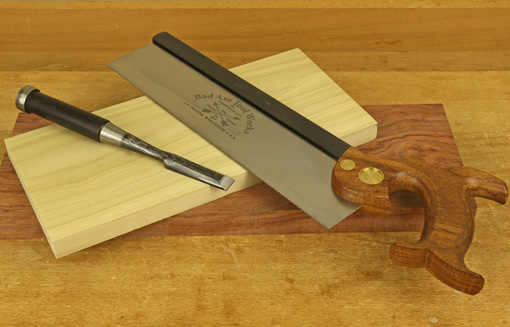
Woodworking instruction and practice usually make use of easily worked woods such as poplar or pine. This is practical – it makes learning easier and fosters confidence.
However, when moving on to more cantankerous woods, the techniques may not be fully applicable. Not only quantitative changes but also qualitative alterations in technique may be necessary. This may surprise and confound the learning woodworker and, as I often say, that includes all of us.
For example, the adjustment in cutting dovetails in red oak after practice in poplar is not just that you have to swing the mallet harder. The tolerances for sawing and fitting that work for the more compressible poplar won’t produce good results in oak. Chopping to the baseline is also different in oak. It helps more to clear the bulk of the waste with a coping saw, yet once done, there is actually less tendency for the chisel to push back beyond the baseline when chopping if it is done in appropriate increments.
The point is that however you like to do it, it pays to reconsider techniques based on the wood at hand.
Hand tool enthusiasts seem to like chopping mortises with a chisel and making tapered sliding dovetails entirely by hand. Fine in pine, poplar, mahogany, and so forth, but how about bubinga? Similarly, I like to hand plane to the final surface whenever practical but for blister maple, hey, it’s time to reach for scrapers or the random orbit sander.
Likewise, someone working almost exclusively in mahogany will surely have accommodated his techniques to that wood and the design style in which he works. That’s good, but it’s not likely that you can transfer all of those techniques and habits to a substantially different wood or style, and certainly you cannot do so unthinkingly.
Woodworkers work in wood, and wood is a very diverse product of nature. We’ve got all sorts of tools – planes with different angles, saws with different teeth, machines with different cutters, and so on. As for anyone good at any skill, a good woodworker ought to have a range of techniques to thoughtfully employ as needed when building in different woods. Further, it pays to be open to expanding that range when encountering unfamiliar woods.


Very good advice. I still haven’t figured out how to handle my favorite, Sapele, minimizing tear out. I hate turning to the ROS. Oak is a snap compared to that.
Thanks, Steve.
Yea, rowey woods are tough. For stock preparation, I find the Shelix cutterhead works great on those woods. The scraper plane (with a “microtoothed” blade, as needed) and hand scrapers can get the surface to where very little hand sanding will finish the job, especially if a film finish will be used.
Rob